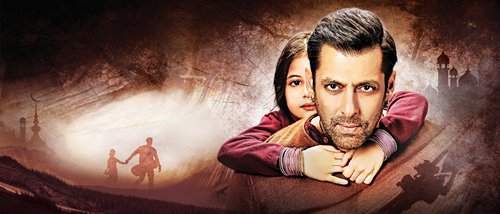
Promotional material for Bajrangi Bhaijaan Photo: IC
Even though Dangal and Secret Superstar's Chinese box office performances have been impressive, Indian films still have a long way to go before they can be considered a major force in the Chinese film market.
"Aamir Khan's success surely helped boost Indian films' popularity in China, but in my opinion, Dangal and Secret Superstar's successes are more individual cases rather than a trend that can be applied to all imported Indian films," Zhang Jin, CEO of Beijing Joy Pictures Co, Ltd - the Chinese distributor of the Indian comedy drama Bajrangi Bhaijaan that recently debuted in the Chinese mainland, told the Global Times on Friday.
Debuting to a mediocre box office performance of 14 million yuan ($2.2m) on Friday, Bajrangi Bhaijaan, which stars Bollywood star Salman Khan, ended up pulling in more than 54 million yuan by Sunday. While this figure is less impressive than the performances of Aamir Khan-led films Dangal (87 million yuan) and Secret Superstar (170 million yuan), but the film has already become the highest-earning non-Aamir Khan Indian film in China.
Cultural barriers
"Actually, the number of Indian films that have succeeded in the mainland, films that focus on love, family and feminist stories such as those from Aamir Khan, is still small," Zhang said.
"What is popular in India might not necessarily be successful in China."
For instance, the 2015 South Indian film Baahubali: The Beginning, which recorded the highest opening day gross worldwide for an Indian film, was released in Chinese mainland cinemas in July 2016 but only grossed 7.49 million yuan in total, not even close to the film's opening day figure of 600 million rupees ($9.48 million) in India, according to a 2015 Variety article.
"Many Chinese audiences, who lack background knowledge about India, might have had a difficult time understanding Baahubali as the film contains a lot of traditional Indian cultural elements," Fei Se, a Chinese film critic and long-time Indian movie fan, told the Global Times.
Around 57 percent of nearly 20,000 users on Chinese media review site Douban gave the film a four-star or above rating, praising its tremendous visuals, especially the film's epic war scenes, while 43 percent gave the film a lower score. The main points of criticism come from audiences complaining about a cliché plot and the sudden appearance of dance routines, something that many Chinese audiences often find awkward when watching Indian films.
"Moreover, the film's poor performance could also be simply because South Indian productions tend to feature a cruder aesthetic style compared with Bollywood films from North India and so the Chinese audience may not like them at all," Fei explained, adding that the film's two-part structure may have also confused the Chinese audiences.
New golden age?
The last time that Indian films experienced a golden age in China was during the late 1970s when Caravan (1971) and Awaara(1951) were first introduced into the mainland. The Chinese dubbed films were big hits and still remain unforgettable memories for many Chinese moviegoers now in their 50s and 60s.
But during the 1980s Chinese mainland audiences started having a larger variety of movies to choose from as more imported films from countries other than India came to cinemas. As competition increased, the performance of imported Indian movies fared badly.
Today's Chinese moviegoers' lack of familiarity with Indian films may also boil down to the fact that these films are only rarely found in the cinemas. A mere six Indian films have screen in Chinese mainland theaters over the past five years - an average of one or two a year.
This average hasn't changed much, even after Dangal's striking success in early 2017, when it earned a whopping 1.3 billion yuan. Among the more than 70 films imported on flat-fee (or buyout) terms in 2017 - a regular means to import an Indian film into the mainland in recent years, only one, Dangal, was from India.
But this may change in 2018, which has already seen the release of two Indian films in the first quarter alone.
According to Zhang, though there are few specific official limitations or quotas on the import of Indian films into the mainland, the selection of ideal candidates is often complicated and takes time, as not every Indian film that has been a hit in its home country may be a right fit for the Chinese market.
Bajrangi Bhaijaan, however, was an exception. Two years ago, Zhang watched the film for the first time on a plane and had since been trying to bring the film to big screens in the mainland.
"Normally we have to go through a long selection process and cost analyses before reaching the decision to import a film, but I decided to import Bajrangi Bhaijaan without worrying too much about business concerns," Zhang told the Global Times.
While most of the Indian films imported into China in recent years have been hit films ranking high on the top 10 Indian box office chart, that might be changing in the future.
"We, as well as many others working in the industry, are trying to import Indian films from different genres rather than the ones we already familiar with," Zhang explained.
The next big hit
When asked to name the latest Indian film that might have the potential to do well in the Chinese market, both Zhang and Fei chose 2017 comedy drama Hindi Medium. The story follows an Indian couple who go to great lengths to send their daughter to a good school. Zhang and Fei said they feel that this is very likely to resonate well with Chinese parents, many of whom are also struggling to provide their children with better education opportunities.
Moreover, co-productions between the two countries may also be ripe for success. The co-produced Kung Fu Yoga grossed a stunning 1.72 billion yuan when it released in the Chinese mainland during the 2017 Spring Festival holiday.


